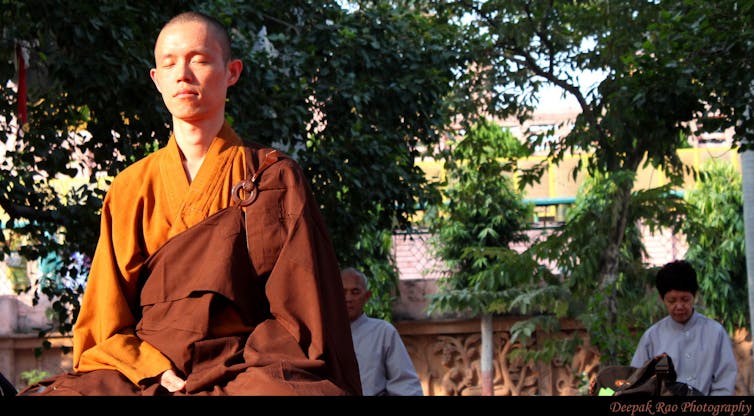Meditation apps might calm you — but miss the point of mindfulness

By Gregory Grieve and Beverley McGuire
In today’s stressful world, mindfulness – a type of popular spirituality that strives to focus on the present moment – promises to soothe away the anxiety and stress of modern life. The Internet is full of popular cure-all mindfulness apps targeting everyone from busy urban professionals to dieters, those suffering from insomnia and even children.
We are scholars of Buddhism who specialize in social media research. In August of 2019, we searched on Apple’s App Store and Google Play and found over 500 apps associated with Buddhism. The majority of the apps centered on the practice of mindfulness.
Do these apps truly promote Buddhist ideals or are they a product of a lucrative consumer industry?
Health benefits
As it is practiced in the U.S. today, mindfulness meditation focuses on being intensely aware, without any sort of judgment, of what one is sensing and feeling in the given moment. Mindfulness practice has been shown to counter the tendency in many of us to spend too much time planning and problem solving, which can be stressful.
Mindfulness practices, as pursued by the Buddhist apps, involve guided meditation, breathing exercises and other forms of relaxation. Clinical tests show that mindfulness relieves stress, anxiety, pain, depression, insomnia and hypertension. However, there have been few studies of mindfulness apps.
The current popular understanding of mindfulness is derived from the Buddhist concept of sati, which describes being aware of one’s body, feelings and other mental states.
In early Buddhist texts mindfulness meant not only paying attention but also remembering what the Buddha taught, so that one could discern between skillful and unskillful thoughts, feelings and actions. This would ultimately lead to liberation from the cycle of birth and death.
For example, the Buddhist text “Satipatthana Sutta” describes not only being mindful of breath and body, but also comparing one’s body to a corpse in a cemetery to appreciate the arising and ceasing of the body.
“One is mindful that the body exists, just to the extent necessary for knowledge and awareness. And one remains detached, grasping at nothing in the world,” the sutra reads.

Deepak Rao, CC BY-NC-ND
Here mindfulness enables one to appreciate impermanence, not become attached to material things and strive to attain greater awareness so that one can ultimately become enlightened.
Early Buddhist mindfulness practitioners were those who criticized mainstream societal values and cultural norms such as bodily beauty, family ties and material wealth.
Mindfulness apps, on the other hand, encourage people to cope with and accommodate to society. They overlook the surrounding causes and conditions of suffering and stress, which may be political, social or economic.
Lucrative industry
Mindfulness apps are part of a massive and lucrative industry valued at roughly US$130 million.
Two apps, Calm and Headspace, claim nearly 70% of the overall market share. These apps cater to a wide audience, which includes religious consumers as well as the growing number of Americans who consider themselves spiritual but not religious.
Americans spend over five hours each day glued to their mobile devices. Nearly 80% of Americans check their smartphones within fifteen minutes of waking up. The apps provide a way to do meditation while on the go.
The fact that Buddhist apps exist is not surprising, as Buddhism has always been skillful at using new media technologies to spread its message. The oldest known printed book, for example, is a Chinese copy of the Diamond Sutra, a Sanskrit Buddhist text that dates to the ninth century.
Are these apps merely repackaging of ancient Buddhism in new digital wrappers?
Is this Buddhist?
There is no doubt that Buddhist apps are a reflection of real social distress. But, in our assessment, mindfulness, when stripped of all its religious elements, may distort understandings of Buddhism.
A core aspect of Buddhism is the concept of no-self: the belief that there is no unchanging, permanent self, soul or other essence. In promoting an individualistic approach to religion, then, Buddhist apps may well rub against the very grain of Buddhist practice.
Indeed, our findings show that Buddhist meditation apps are not a cure that relieves suffering in the world, but more like an opiate that hides the real symptoms of the precarious and stressful state in which many people find themselves today.
In that case, Buddhist apps, rather than curing the anxiety created by our smartphones, just make us more addicted to them and, in the end, even more stressed.
![]()
[Gregory Grieve, Head and Professor, Religious Studies Department, University of North Carolina – Greensboro and Beverley McGuire, Professor of East Asian Religions, University of North Carolina Wilmington]
This article is republished from The Conversation under a Creative Commons license. Read the original article.
Related

Pilgrims of Hope, Episode 6: Walking with Cancer Survivors
Hosted by Fr. Ron Will, C.PP.S.
We are talking with people who find hope amid difficult circumstances or bring hope to others. In this episode, Kathy Keary talks about how centering prayer, journaling and other spiritual practices helped her cope with two life threatening health issues.

The Rollercoaster Torture
An Assembling God’s Puzzle video
By Fr. Garry Richmeier, C.PP.S.
Life is full of ups and downs, like a roller coaster, and that fact is a piece of life’s puzzle that we must deal with. Depending on how we deal with it, it can be torture, or it can be simply another difficult aspect of life to be navigated. How do we avoid the torture?
Categories
Assembling God's Puzzle Coffee with Padre Cooking & Spirituality Encounters of the 4th Kind Family Matters Reflections on the Eucharsitic Prayers Spiritual Resources Taize Prayers The Contemplative Life Traveling with Pilgrims of Hope Uncategorized Videos Week of Prayer for Uhristian Unity When you need a little help
